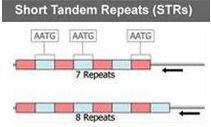

If you would like to participate please contact us. Donations to the general fund to support those who cannot afford the cost of the test are welcome.
DNA STUDY


There are a number of genealogical DNA tests available, which fall in to broadly three types - autosomal testing, Y-STR testing, and SNP testing
Autosomal testing
Sometimes known as the family finder test, this is only useful looking back 5-6 generations. This tests identifies relationships from both male and female lines as opposed to the Y-STR test which only looks the the male Y Chromosome. In each generation, DNA is divided and mixed so that offspring share 50% of each parent’s code. Autosomal testing looks at the DNA of individuals to see how much code is shared, but as each generation sees shared code halve, after a few generations, there is little code left to compare - hence why it is not useful beyond 6 generations. For example, first cousins will share around 13% of their DNA, second cousins will share around 3%, third cousins will share around 0.8%. As the amounts become very small, matches become less valid.
Y-STR testing
As this tests looks at just the Y-chromosome which is passed generally intact from male to male, the results can look back many generations for matches. The test looks at ‘junk’ fillers between genes which only change if there is a mutation between generations. If the testing points, known as ‘markers’, are the same in two males, they are related. The test is known as a Y-STR test, where STR stands for ‘short tandem repeat’ which is explained below. The test is conducted by sending a cheek swab back to the testing company. 
A mutation is simply a change in the DNA sequence which occurs when a cell is dividing and a certain enzyme fails to copy the DNA correctly. Cells divide through a process called mitosis, where the DNA makes a copy of itself and passes it to the new cell, using an enzyme called DNA Polymerase. This enzyme reads the original code along the chain, and builds the new strand of DNA. The code is made up of a very long pattern of four different nucleotides, abbreviated to A,T,C, and G. At certain points, the DNA code repeats itself (this is a short tandem repeat, or STR) and sometimes there is a slippage so that for example instead of 7 repeats, we can get 8. This error does not happen very often which makes this kind of analysis very useful to determine relationships and ancestry. An error in these areas does not affect the operation of the cell as it is contained in a junk region of the DNA.
The test results themselves are meaningless, except for comparison to another person. The naming convention for each marker is usually a code prefixed by ‘DYS’, and the test result for each marker is assigned a number equal to the number of times that the DNA sequence is repeated at that location. For example where DYS455=7, the marker point is named DYS455, and the value of 7 means that the DNA code is repeated 7 times. If the value of two people tested at location DYS455 is the same, there is a match. The number of matches, can be used to calculate the TMRCA - the length of time to most recent common ancestor.
SNP testing
This looks far further back, usually beyond 1000 years and can be useful in pinning down much older connections given the general lack of use of surnames prior to 1500 AD.
Are you concerned about STR DNA testing? If so, read what ancestral testing is NOT!
Genealogical Y-STR DNA testing is NOT the same as forensic DNA testing that you get in police investigations and on tv. Forensic tests look at genetic profiles that are not held on the Y chromosome and thus are not used in genealogical Y-STR DNA testing.
Genealogical Y-STR DNA testing is NOT the same as medical DNA testing which aims at diagnosing genetic disorders looking at active gene portions of our chromosomes. Genealogical Y-STR DNA testing examines tiny sections from the filler (junk) DNA of the Y chromosome which does not yield any direct information about the active genes of the Y chromosome. Genealogical testing therefore is not used to show genetic disorders caused by abnormalities in genes on other chromosomes or on the Y chromosome.
Genealogical Y-STR DNA testing is NOT the same as paternity DNA testing which spreads the test over several chromosomes and is not confined to the Y chromosome as with genealogical testing. However, genealogical testing can reveal some unexpected male family relationship facts eg two brothers take the same genealogical DNA test, it could be shown that they don't have the same father. Nothing is revealed regarding any family relationships involving females.